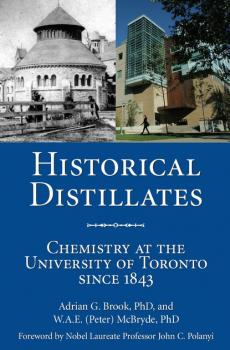ТОП просматриваемых книг сайта:
Учебная литература
Различные книги в жанре Учебная литература, доступные для чтения и скачиванияАннотация
Macdonald Institute traces the evolution of a small post-secondary institution specializing in the education of rural Ontario women into a world-respected, co-educational college at the University of Guelph. Built in 1903 with funds from Sir William Macdonald of Montreal, Macdonald Institute focused originally on the teaching of Domestic Science to rural women. «Mac» has evolved to meet the changing needs of women, the Canadian family and society in general. The Institute evolved into the College of Family and Consumer Studies in 1970 and its legacy is now an integral part of the College of Social and Applied Human Sciences. This book provides valuable insights into the education of women in Ontario in the twentieth century.
Аннотация
Commended for the 2009 Best Books for Kids & Teens, long-listed for the 2009 CLA Book of the Year for Children Award Twelve-year-old Lewis Castorman is a master locksmith: there is no lock on earth that he is unable to open. He is therefore flattered when world-renowned chemist Ernst K. Grumpel invites him to his office in New York City and offers him a lock-picking assignment. His confidence quickly turns to dismay, however, when he learns this job will take him to Yellow Swamp in northern Alberta, the scene of a disastrous chemical spill a year earlier. He is also horrified to discover that Grumpel is utterly ruthless and, through his chemical inventions, can alter the rules of nature at his will. But the assignment is one that Lewis can’t refuse. How is Grumpel able to create such miraculous transformations? What secrets has he locked away and why has he taken pains to store them in Alberta? Despite the strange discoveries Lewis will make at every turn in his adventures, nothing will prepare him for the final encounter that awaits him in Yellow Swamp.
Информация о книге
Автор произведения Nicholas Maes
Жанр Учебная литература
Серия A Felix Taylor Adventure
Аннотация
Historical Distillates examines the history of the Chemistry Department at the University of Toronto from its beginnings in 1843, when it was housed in simple quarters in the Parliament Buildings on Front Street and had just one faculty member. During the founding era (1843-1920) three British gentlemen professors guided the department through four homes; between 1920 and 1960 three Canadian heads built a highly influential department. Since 1960 eight chairmen have effectively managed a growing and diverse department while it ventured into exciting new fields and emerging sub-disciplines. New colleges and a Nobel Prize have been highlights of the past two decades. With the completion of recent renovations and additions (such as the Davenport Research Building and Garden), with its distinguished faculty, top-rate staff, and excellent students, and with its dazzling array of equipment to support research, the department’s future indeed looks bright.
Аннотация
Commended for the 2009 Best Books for Kids & Teens Canadian World War II pilot Charley Fox, now in his late eighties, has had a thrilling life, especially on the day in July 1944 in France when he spotted a black staff car, the kind usually employed to drive high-ranking Third Reich dignitaries. Already noted for his skill in dive-bombing and strafing the enemy, Fox went in to attack the automobile. As it turned out, the car contained famed German General Erwin Rommel, the Desert Fox, and Charley succeeded in wounding him. Rommel, who at the time was the Germans’ supreme military commander in France orchestrating the Nazis’ resistance to the D-day invasion, was never the same after that. Author Steve Pitt focuses on this seminal event in Charley Fox’s life and in the war, but he also provides fascinating aspects of the period, including profiles of noted ace pilots Buzz Beurling and Billy Bishop, Jr., and Great Escape architect Walter Floody, as well as sidebars about Hurricanes, Spitfires, and Messerschmitts.
Аннотация
How has the Ontario Agricultural College contributed to Canadian education? What role has the college played in the development of agriculture since it was founded in 1874? This history of Canada's oldest agricultural college revolves around these two questions. It shows that the college's mandate has changed in its attempt to serve both education and agriculture. The Ontario Agricultural College was established to enshrine science in farming, but it also became the testing and extension arm of the provincial ministry of agriculture. Direct government control for ninety years provided financial resources not enjoyed by other post-secondary schools, but the results sometimes proved of greater benefit to agriculture than to education or science. Swept into the University of Guelph when it was created in 1964, the college rethought its role. It emerged as a centre for advanced scientific inquiry, for global agricultural programs, and for understanding rural societies. The controversies surrounding these changes and the evolving nature of agriculture and science are brought out fully in this account of the past century and a quarter.
Аннотация
Many saw it as a gamble for Jean Chretien: against the advice of party members, he called an early election. But the gamble paid off, and the Liberal Party cruised to their third straight majority government. The Canadian General Election of 2000 is the authoritative study of the campaign and election. As with previous volumes in the Canadian General Election series, the 2000 edition includes analyses of: the campaigns of all five major parties the roles of the print and electronic media, including the internet the pre-election polls voting behaviour across the country Articles are contributed by some of the most recognizable political writers, commentators, and pollsters, including: Edward Greenspon., Stephen Clarkson, Faron Ellis, Alan Whitehorn, Peter Woolstencroft, Andre Bernard, Paul Attallah, Mary McGuire, Janice Neil, Michael Marzolini, and Andre Turcotte.
Аннотация
The General Election of 1997 did not turn out as Jean Chretien and the Liberal Party had planned. Chretien called an early election, believing that his party was in a position to retain the majority they had won in 1993. They got their majority, but just barely. When the campaign began, the focus for many Canadians was the economy and job creation. National unity, however, quickly became a key issue, and triggered the most heated debates of the campaign. As was the case in 1993, the election of 1997 saw the country divided along regional lines. The Bloc Quebecois remained strong in Quebec, while the Progressive Conservatives and New Democrats dominated the maritime provinces. The Reform Party, meanwhile, won the west in a landslide, becoming the Official Opposition for the first time. It was Ontario, however, where the election was won: the Liberals won all but two seats in Canada's largest province, and in the end that was enough to carry Jean Chretien to victory. The Canadian General Election of 1997 is a study of the key aspects of the campaign and the election itself. In addition to analyzing each party's campaign, authors examine the role of the media, pollsters, the electoral system, and the voters. Articles are contributed by some of the best-known political writers in Canada today: Anthony Westell, Stephen Clarkson, Peter Woolstencroft, Alan Whitehorn, Keith Archer, Faron Ellis, AndrÈ Bernard, Chris Dornan, Ed Greenspon, Michael Marzolini, and Louis Massicotte. This readable volume will appeal to an academic as well as a general readership, and is ideally suited for libraries and political science courses. New to this year's volume is a post-election survey by Jon Pammett.
Аннотация
Bridget Quinlan is a spirited 13-year-old when the Irish potato famine of the 1840s shatters her life. Although her home is a hovel with few possessions, her family survives as long as her father can grow a good crop of potatoes on his small piece of land. Tragedy strikes when crops fail and typhus spreads, killing one of the boys in her school and then her brother, Rory. With soldiers evicting the ill and unemployed, the Quinlans are forced to accept the offer of a passage to Canada. Appalling conditions onboard contribute to many deaths so that by the time they reach Grosse Île, Quebec, Bridget and her sister are alone in the world. The two are adopted by a kind farming family and gradually settle into their new life. After all the sadness and loss, a surprising turn of events brings them lasting joy.
Аннотация
Celebrated as the saviour of Upper Canada, Major General Sir Isaac Brock was a charismatic leader who won the respect not only of his own troops, but also of the Shawnee chief Tecumseh and even men among his enemy. His motto could well have been ’speak loud and look big.’ Although this attitude earned him a reputation for brashness, it also enabled his success and propelled him into the significant role he would play in the War of 1812.
Аннотация
Commended for the 2009 Best Books for Kids & Teens For more than 40 years Canadian orders, decorations, and medals have been used to recognize exemplary citizens for their outstanding contributions to our country and to the world. Although Canada is a relatively young country, we are fortunate to have one of the most comprehensive honours systems in the world. With the Order of Canada at its centre, the Canadian honours system includes the Victoria Cross, Star of Courage, Order of St. John, General Campaign Star, Canadian Forces Decoration, and a wide variety of other awards. From the honours of New France to the many British medals awarded to Canadians prior to 1967, the various elements of the modern Canadian honours system are explained. This short book, rich with illustrations and photos, provides an easy-to-understand overview of Canadian honours, who has received them, and how they are bestowed. The book also includes a wearing guide.










